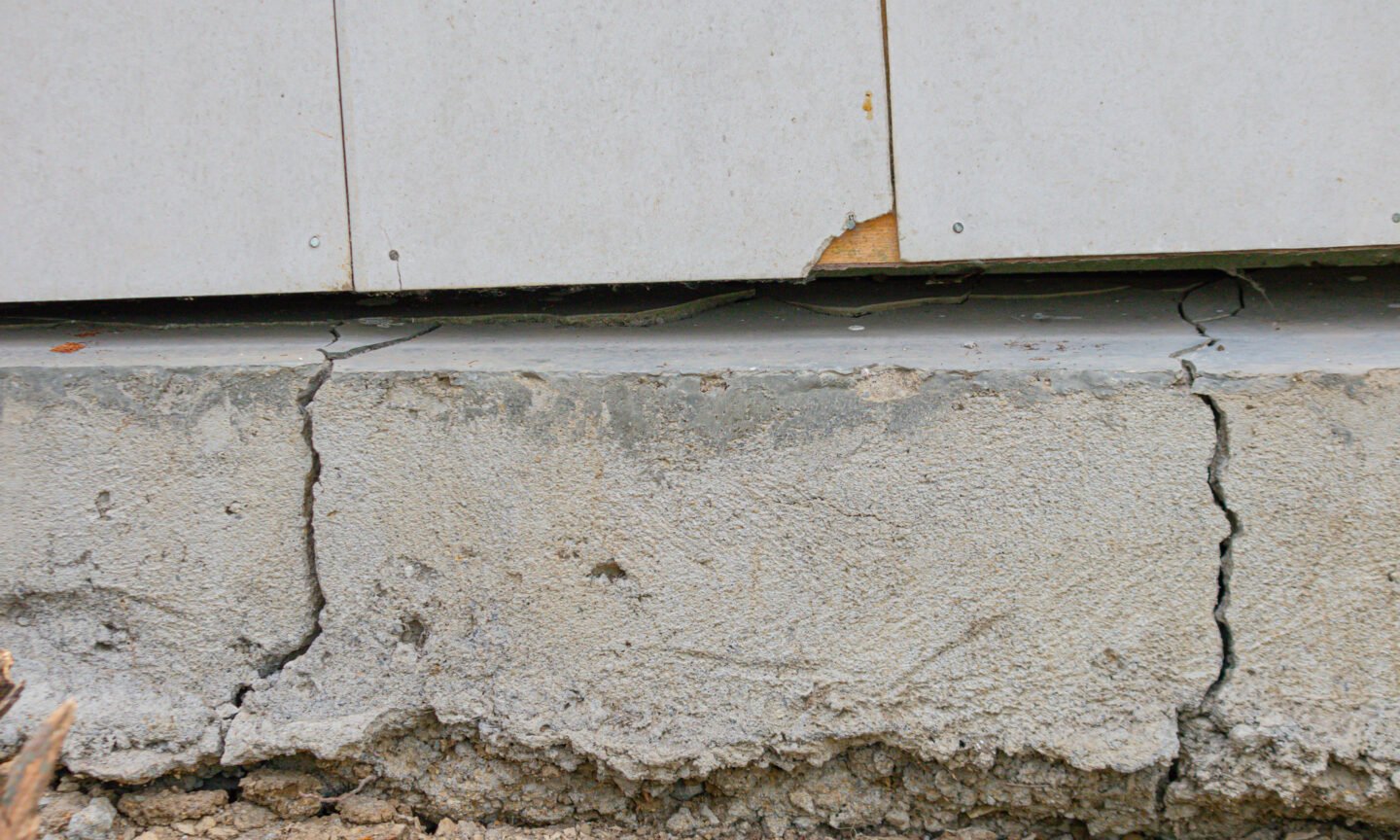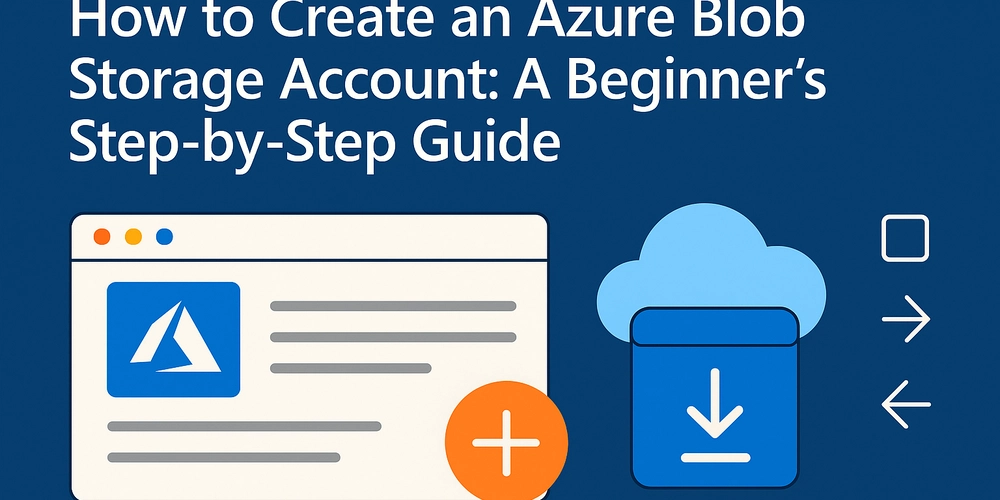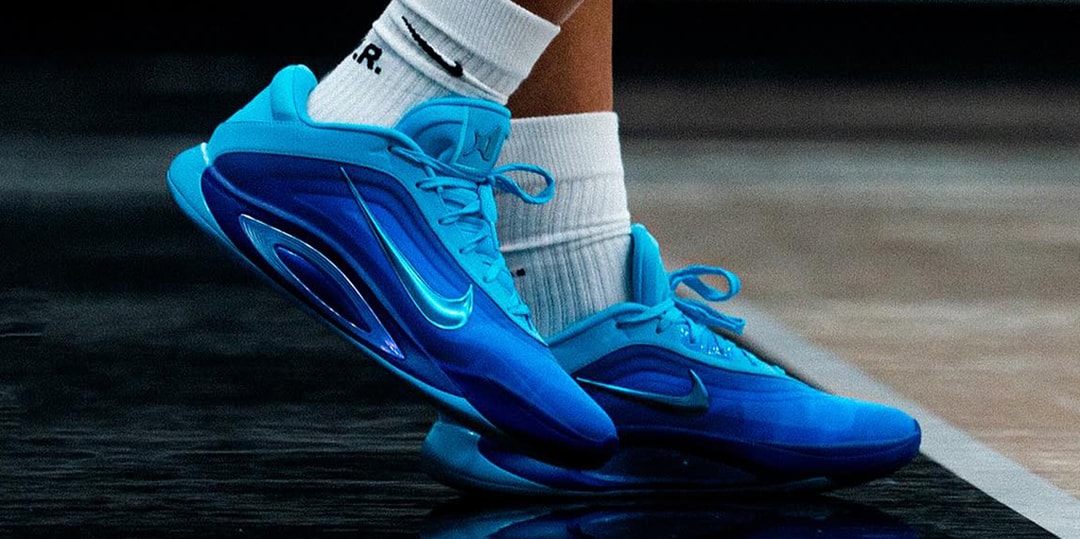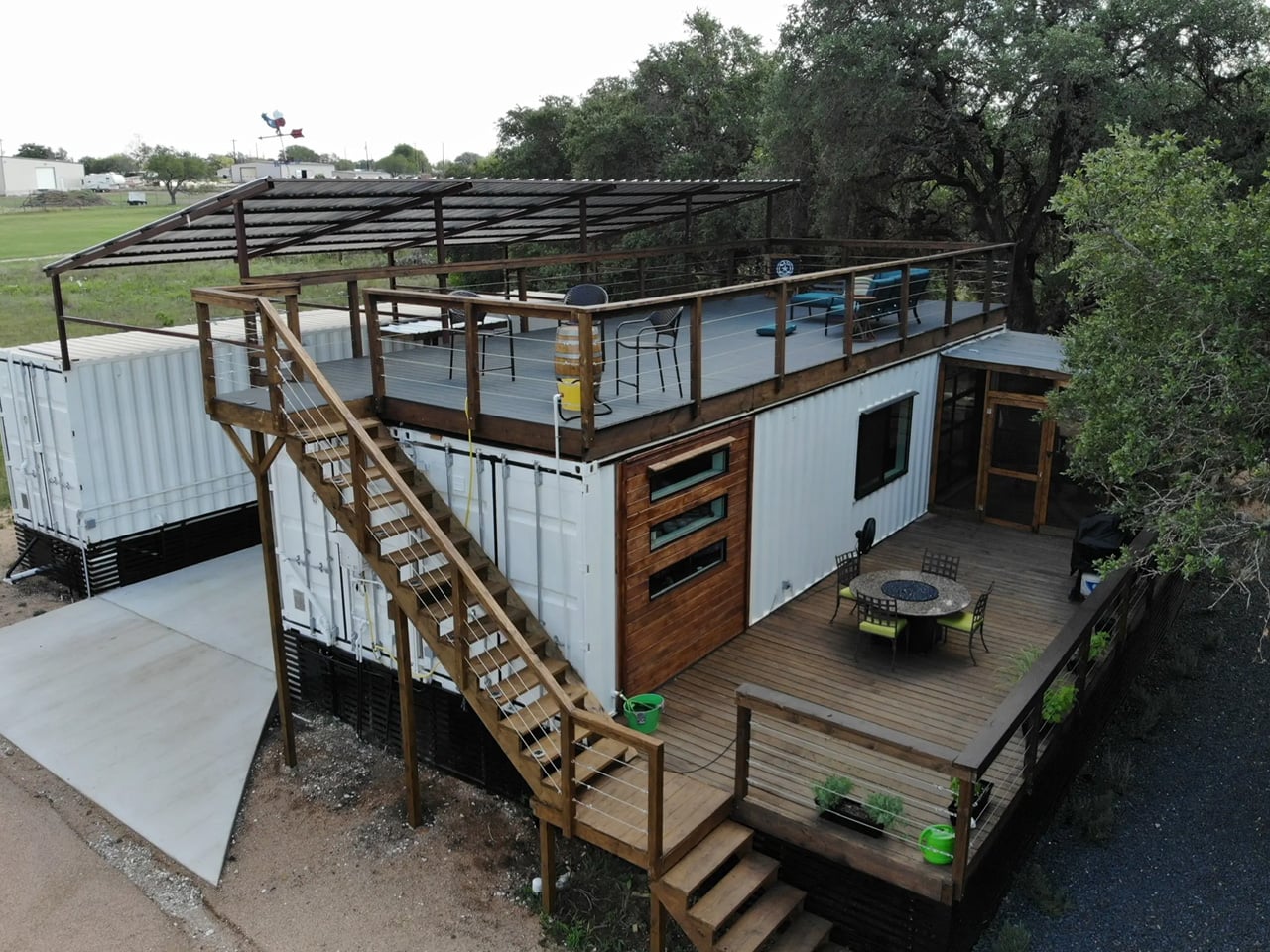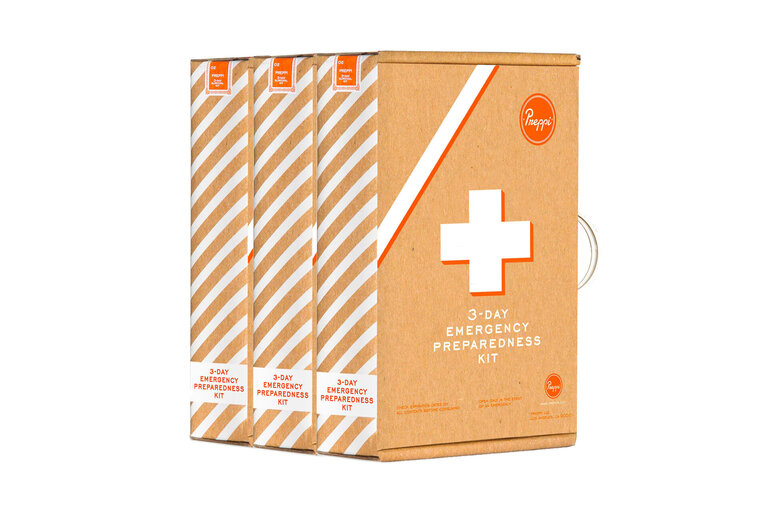The Best Deadlift Alternatives for Building Raw Strength and Power
Hit your glutes, hamstrings, and back—no barbell required.
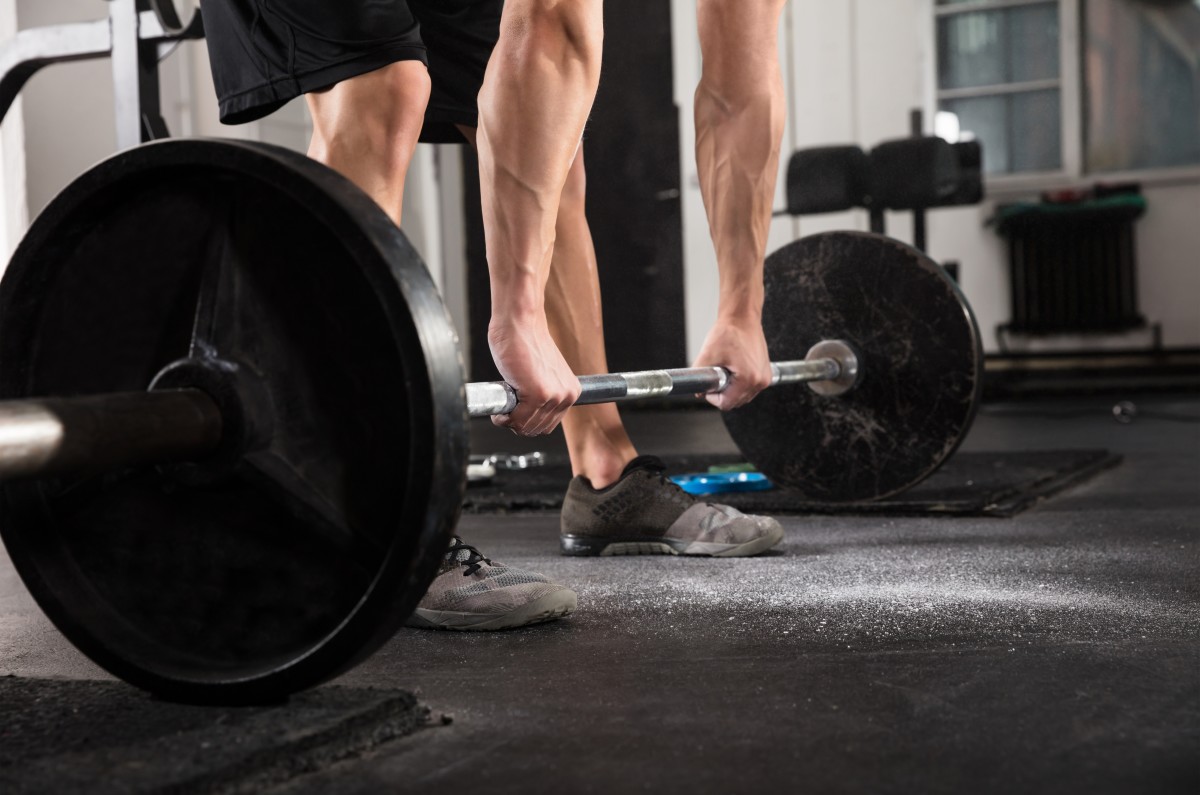
If you’re looking for an exercise that does it all, it’s hard to find one that beats the deadlift. As a compound movement, it targets multiple muscle groups simultaneously, including the hamstrings, glutes, quads, and lower back. It’s also very functional, meaning it mimics the movement patterns we perform in our daily lives. Every time you pick something heavy up off the floor, hopefully using your legs, you’re performing a deadlift.
Even though the traditional barbell deadlift is one of the most effective exercises for building overall strength, it isn’t the right fit for everyone. Mobility issues, chronic back pain, or simply a lack of equipment can make performing this exercise difficult. Fortunately, there are plenty of deadlift alternatives that will still deliver great results.
In this article, I’ll use my experience as a personal trainer to share 10 of the best deadlift alternative exercises to help you build a strong posterior chain, all without needing a barbell.
Related: How to Do Hanging Leg Raises for Rock-Solid Abs
The 10 Best Deadlift Alternatives
Good Mornings
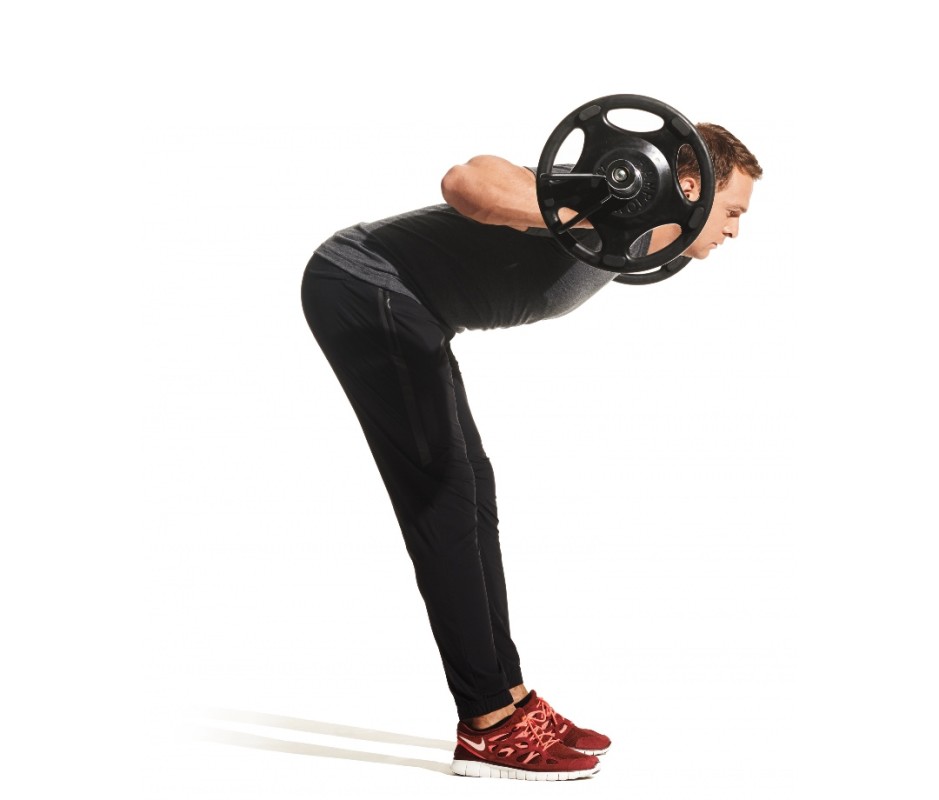
James Michelfelder
Similar to the deadlift, the good morning is a hinging movement that targets the hamstrings, glutes, and lower back, which are all part of the posterior chain. The benefit of the good morning lies in its versatility—it can be performed using just your body weight or with resistance in the form of a band or weight.
How to Do It
- If you’re adding resistance, grab a band, weight plate, dumbbell, or barbell.
- Start in a shoulder-width stance with knees slightly bent and a tall chest.
- Keeping your core braced, push your hips backwards as if you were trying to close a door with your glutes.
- Continue hinging at the hips until your torso is roughly parallel to the floor. Maintain a neutral spine throughout the entire movement (at the bottom of the move, you should be looking down at the floor).
- Squeeze your glutes and drive your hips forward to return to the standing position.
Pro Tip
- If you’re performing bodyweight good mornings, I suggest placing your hands behind your head in the prisoner pose.
- If you’re using a band, step inside and on top of the band, and then bend down to loop the band around your neck.
- If you’re using a weight plate or dumbbell, you can hold it across your upper back like you would a barbell or hold it in front of your body against your chest.
- If you’re using a barbell, place it in the back-rack position as if you were performing a barbell squat.
Back Extension
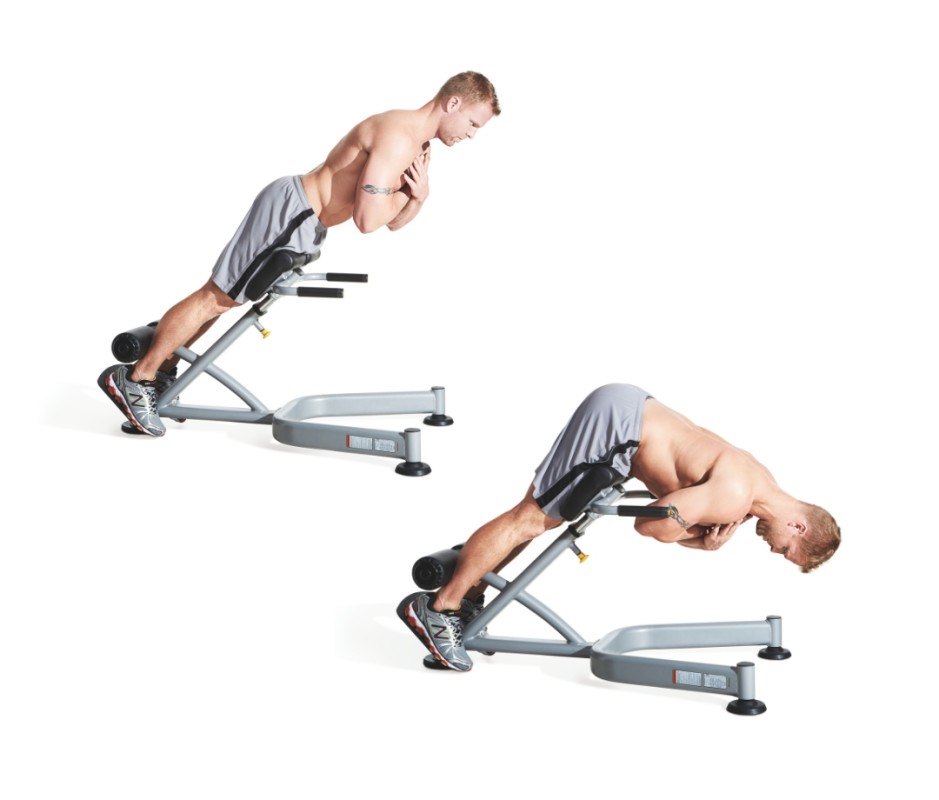
Beth Bischoff
The back extension is another great exercise for targeting and strengthening the hamstrings, glutes, and lower back. For this exercise, you will need access to a back extension machine or GHD (glute-ham developer), but these can be found at almost all commercial gyms.
How to Do It
- Start by adjusting the pad on the machines so it rests just below your hips, and place your feet securely under the footpads.
- As far as arm positioning, you can cross them in front of your chest or place them behind your head in the prisoner pose. If you’d like to add resistance, you can also hold a plate or dumbbell in front of your chest.
- Keeping a neutral spine, hinge at the hips, and slowly lower your chest towards the floor while maintaining a tight core.
- Lower your chest until you feel a strong stretch in your hamstrings, or your torso is about 45 degrees below parallel.
- Engage your glutes and hamstrings to lift your chest back to the starting position.
- Stop when your body forms a straight line to avoid hyperextending your back at the top of the rep.
Superman Hold
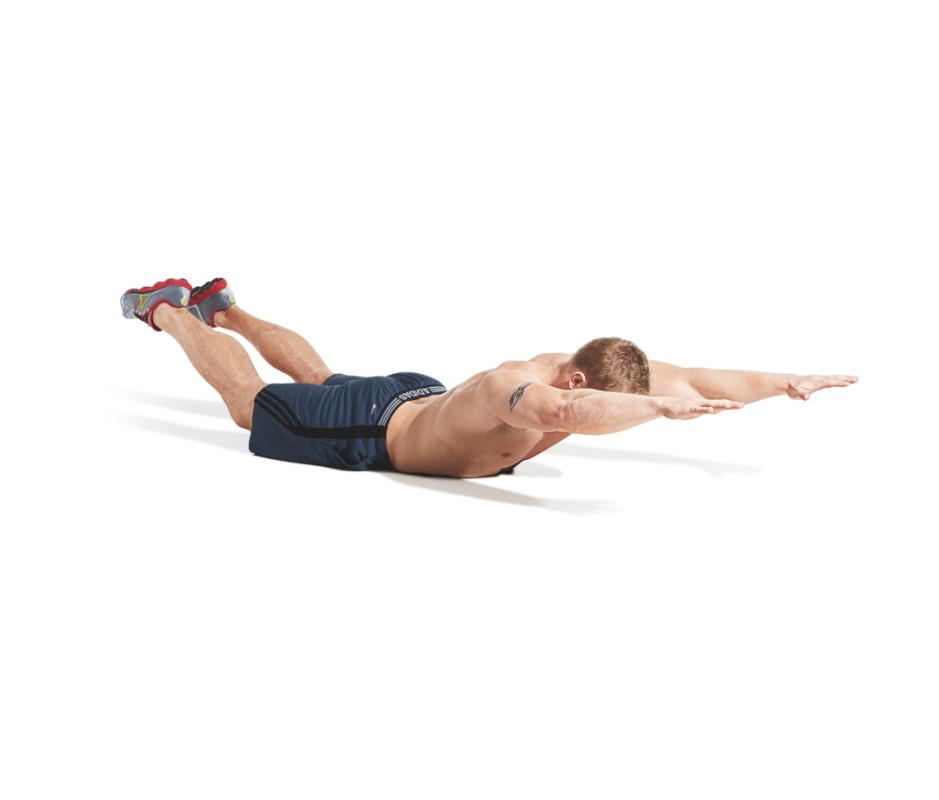
Beth Bischoff
If you don’t have access to a back extension or GHD machine, the superman hold is a fantastic bodyweight alternative that still targets your lower back and glutes. It’s a simple movement, but great for developing muscular endurance and stability in the muscles of the posterior chain. Plus, it can be done anywhere since no equipment is needed.
How to Do It
- Start by lying face down on the floor with your legs extended straight behind you and your arms extended straight in front of you.
- Keep a neutral spine position by looking straight down at the floor.
- Simultaneously lift your legs, arms, and the top of your chest a few inches off the ground by squeezing your glutes and bracing your core.
- Keep your arms and legs as straight as possible, and aim to create a gentle arch through your body without straining your lower back.
- Maintain the top of the movement for a few seconds and then slowly lower your arms and legs back down to the floor.
- Focus on squeezing the muscles of the glutes and the lower back and performing slow and controlled reps.
Sumo Deadlift
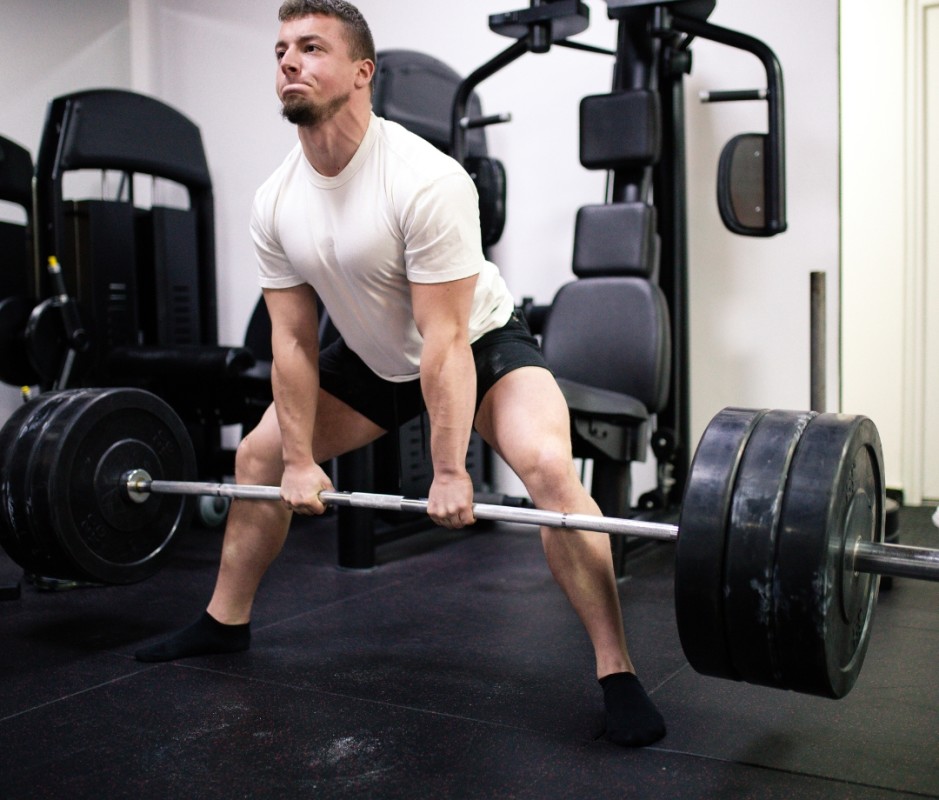
Getty Images/Radomir Jovanovic
The sumo deadlift is a variation of the conventional deadlift that uses a wider stance and a more upright chest position. One of the key benefits of the sumo stance is that it shortens the range of motion needed to perform the lift, making it a great option for individuals with mobility limitations or those dealing with lower back pain.
How to Do It
- Place a barbell, dumbbell, or kettlebell on the floor in front of you.
- Get into the sumo stance by moving your feet wider than shoulder-width and pointing your toes out to the side at about a 30-degree angle.
- Hinge at the hips and bend your knees to lower your hands down to the weight.
- Maintain a tall chest and neutral spine as you grab the weight inside of your knees.
- Brace your core and pull your shoulder blades back slightly to stabilize your upper body.
- Keeping your arms straight, squeeze your glutes and then drive through your feet to lift the weight off the floor, extending your hips and knees at the top of the rep.
Single-Leg Romanian Deadlift
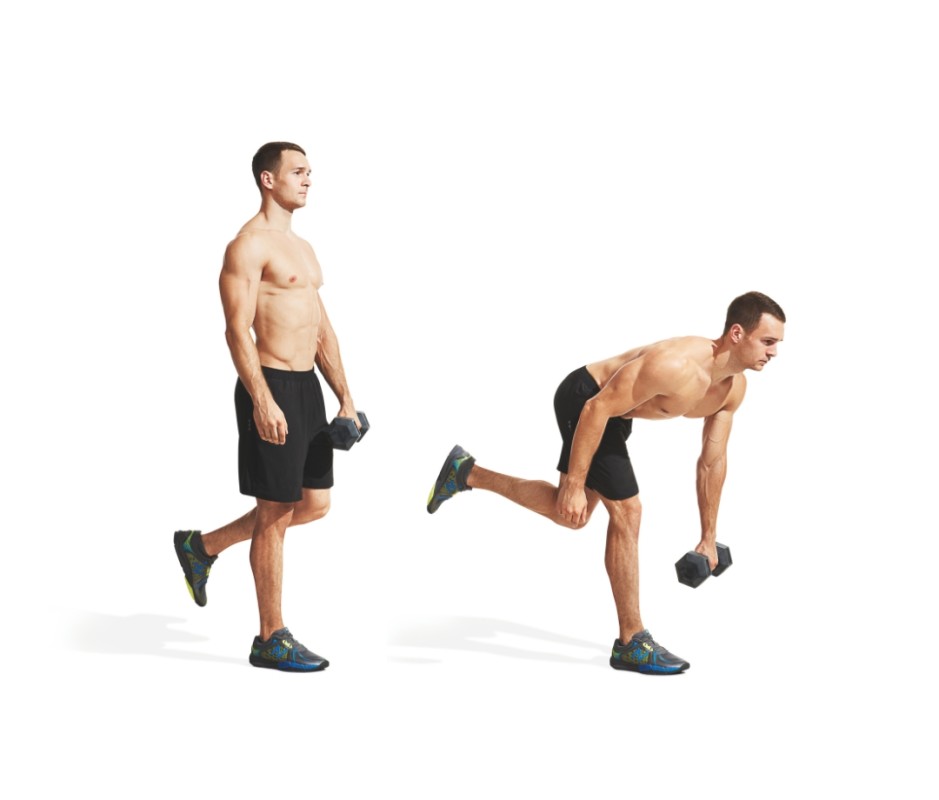
Beth Bischoff
The single-leg Romanian deadlift, also known as the single-leg RDL, is a deadlift variation that’s designed to strengthen your hamstrings, glutes, and core. Unlike the traditional deadlift, this exercise is performed on one leg, which can help to correct muscular imbalances as well as improve your balance and coordination. I prefer using a kettlebell for this exercise because of the easy-to-grip handle, but a dumbbell also works if that’s what you have available.
How to Do It
- It’s generally recommended to hold the kettlebell or dumbbell in the hand opposite of the leg that will remain planted on the ground.
- Start by shifting your weight onto the working leg, keeping a slight bend in the knee.
- Hinge at the hips, sending them back as you lower your chest to the ground. Your arm holding the weight should remain straight and locked out at the elbow.
- At the same time, your non-working leg should extend out behind you for balance.
- Lower the weight slowly, keeping it close to your standing leg. I like to aim to place the weight right on the inside of my standing leg's big toe.
- At the end of your range of motion, your chest should be parallel to the floor and you should feel a strong stretch in your working leg’s hamstring. Only go as low as you can while maintaining a flat back and neutral spine position.
- Finish the movement by driving through your foot and squeezing your glutes to bring your chest back to the upright starting position.
- Perform the desired number of reps and then switch legs.
Bench-Supported Hip Thrust
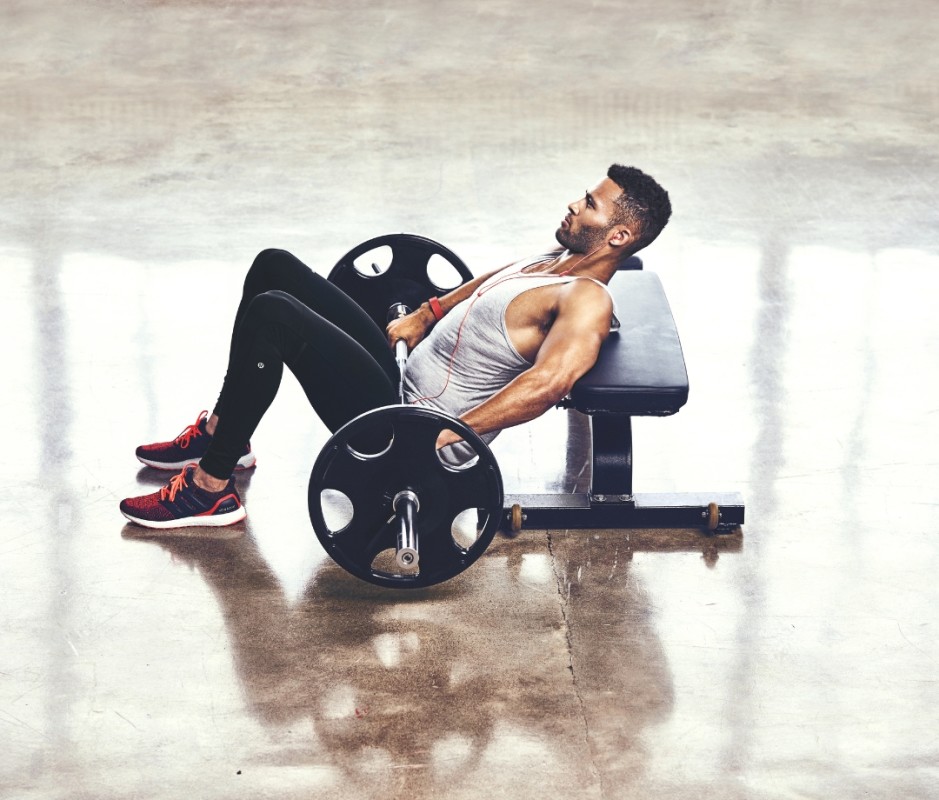
James Michelfelder
The hip thrust is another great deadlift alternative for targeting the glutes and hamstrings. For this exercise, you’ll need a bench for support and a dumbbell, barbell, or weight plate for some resistance.
How to Do It
- Start by sitting on the floor with your upper back pressed up against a sturdy bench.
- If you’re using a barbell, roll it over your hips so it sits right in your hip crease. If you’re using a dumbbell or weight plate, place the weight as close to your hip crease as possible.
- Bend your knees and plant your feet flat on the ground about hip-width apart. At the top of the movement, your shins should be roughly 90 degrees to the ground.
- Lean back against the bench so that the edge of the bench lines up just below your shoulder blades.
- Place your elbows firmly on the bench and press down slightly into the bench for support.
- Start the lift by engaging your core and driving through your feet as you lift your hips up towards the ceiling so that your body forms a straight line from your shoulders to your knees.
- Squeeze your glutes hard at the top of the rep and pause for a second or two while maintaining a strong glute contraction.
- Slowly lower your hips back to the ground while maintaining tension through the glutes.
Glute Bridge
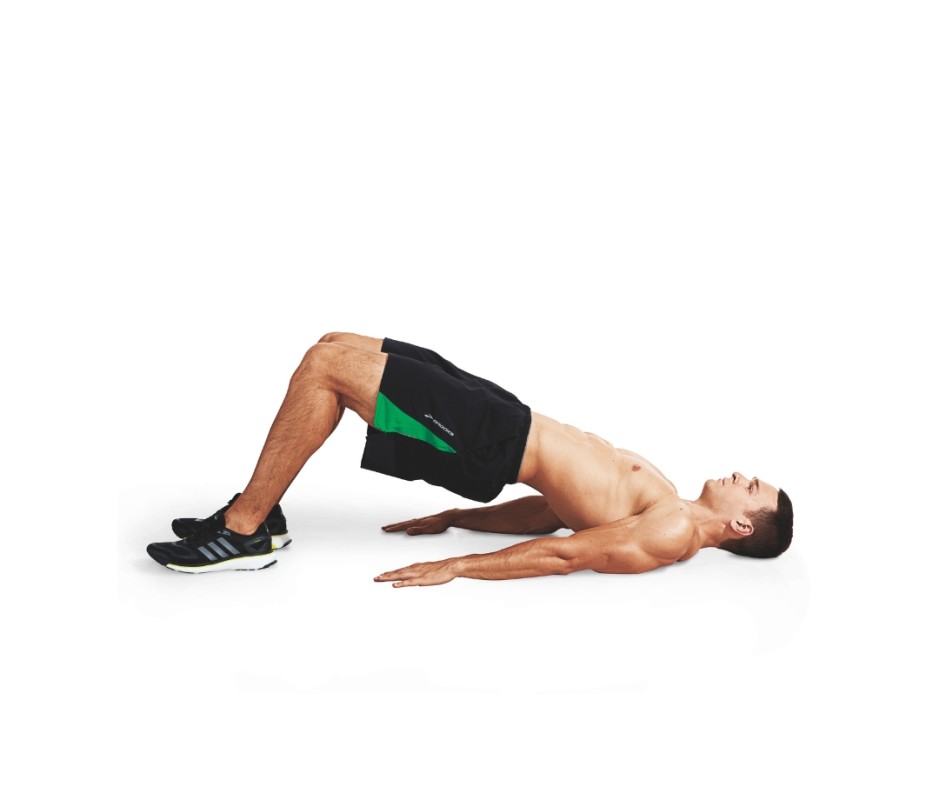
Beth Bischoff
The glute bridge is very similar to the hip thrust, and it’s a great alternative if you don’t have access to a bench. You can perform the glute bridge with just your bodyweight or make it more challenging by using one leg at a time or by adding resistance with a dumbbell or weight plate.
How to Do It
- Lie down on the floor flat on your back and bring your knees up to a bent position, hip-width apart, so that your feet are planted firmly on the floor.
- If you’re using a weight, place the dumbbell or weight plate across your hips and hold it securely using both hands.
- Start the movement by engaging your core and pushing through your feet as you lift your hips up towards the ceiling.
- Squeeze your glutes hard at the top of the rep and pause for a second or two while maintaining a strong glute contraction.
- Slowly lower your hips back down to the ground while maintaining tension through the glutes.
Farmer’s Carry
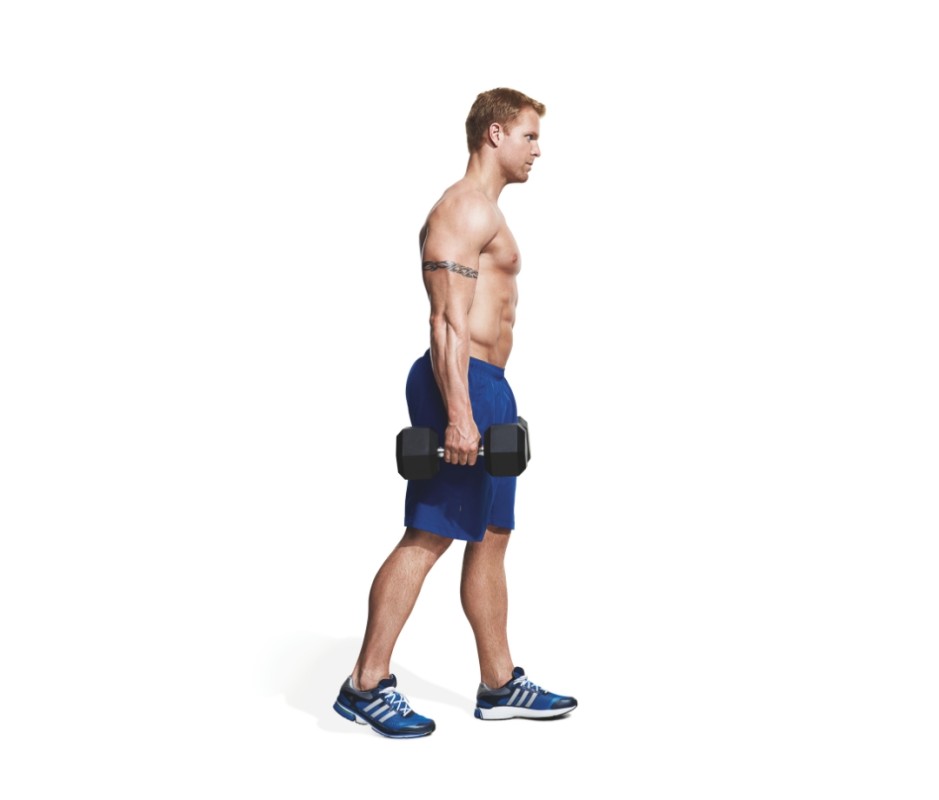
Beth Bischoff
The farmer’s carry, which involves picking up heavy weights and carrying them for a set distance, is one of the most functional movements you can do. Every time you carry grocery bags from the car or haul your luggage around the airport, you're performing a farmer’s carry.
At first glance, the farmer’s carry may not look very similar to the deadlift. However, to even perform the exercise, you have to deadlift the weights up off the ground. Beyond that initial lift, the farmer’s carry requires a strong and stable core to effectively move the weight, which is another key component of the deadlift. Carries are also an excellent way to build up your grip strength, which is important if you’re looking to improve your deadlift numbers and lift heavier weights.
How to Do It
- The farmer’s carry is typically performed using a pair of heavy dumbbells, kettlebells, or specialized bars with handles that are made for this movement. So start by grabbing your weights.
- Set the weights out on the floor in front of you about shoulder width apart.
- Standing between the weights, hinge at your hips, bend your knees slightly, and reach down for the weights, just like you're setting up for a deadlift.
- Keeping a neutral spine, grab the weights and drive through your feet to stand up tall, extending your hips and knees at the top.
- Pull your shoulders slightly back and down to avoid shrugging the weight and take small and controlled steps forward while maintaining a strong core and upright posture.
- Walk for a set distance, or set amount of time, and then carefully lower the weights back down to the ground using the same deadlift pattern.
- Note: If performing the initial deadlift is an issue, you can modify the setup to make it easier. Either have a partner hand you the weights while you’re already standing, or place the weights on an elevated surface like a box or bench. This way, you can avoid the initial deadlift while still getting the benefits of the farmer’s carry.
Cable Pull-Through
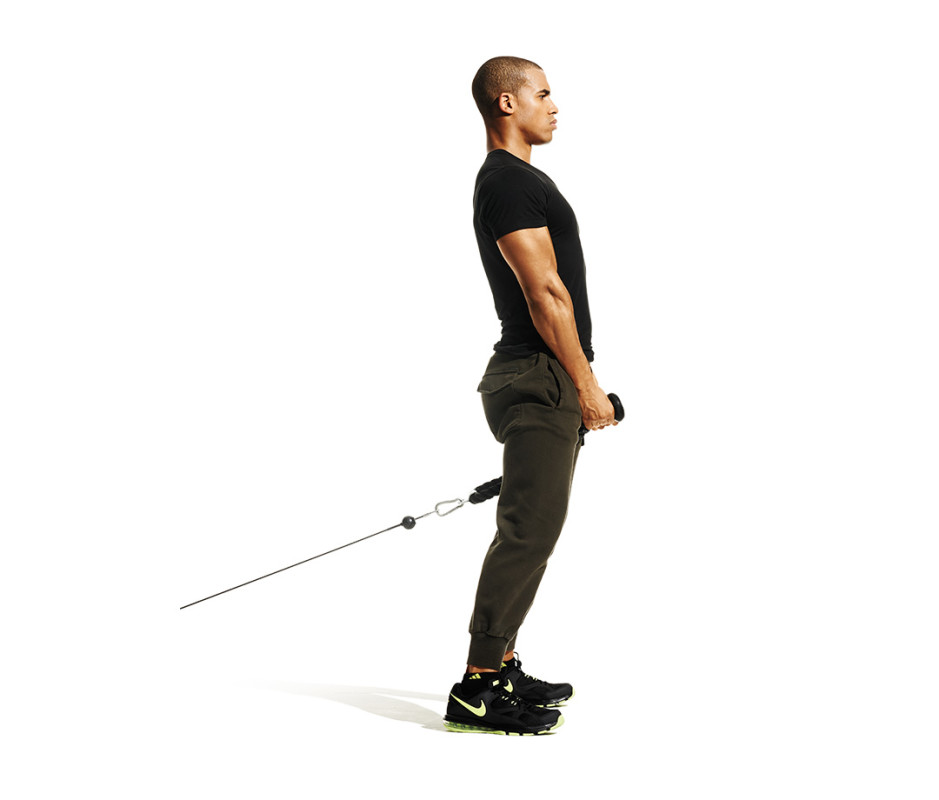
James Michelfelder
The cable pull-through is an excellent deadlift alternative because it mimics the hip hinge movement pattern without loading the spine. This means it’s easy on the back and a great way to teach proper deadlift mechanics to individuals who are new to the gym. If you don’t have a cable machine with a rope attachment for this exercise, you can make due by wrapping a band around something sturdy like a squat rack.
How to Do It
- Attach a rope to a cable machine and move the cable attachment down to the lowest setting.
- Facing away from the machine, straddle the rope between your legs and grab the rope handles with both hands.
- Walk a few feet away from the machine until you feel some tension in the cable.
- Your feet should be positioned about hip-width apart and your knees should have a slight bend.
- Start the movement by pushing your hips back towards the cable machine while keeping your chest upright and maintaining a neutral spine.
- Allow your arms to follow the path of the rope between your legs as the cable pulls back.
- Once you feel a strong stretch in your hamstrings, squeeze your glutes and drive your hips forward to return to the standing position.
- Be sure to keep the tension in the cable throughout the entire movement to maximize muscle engagement.
Kettlebell Swings
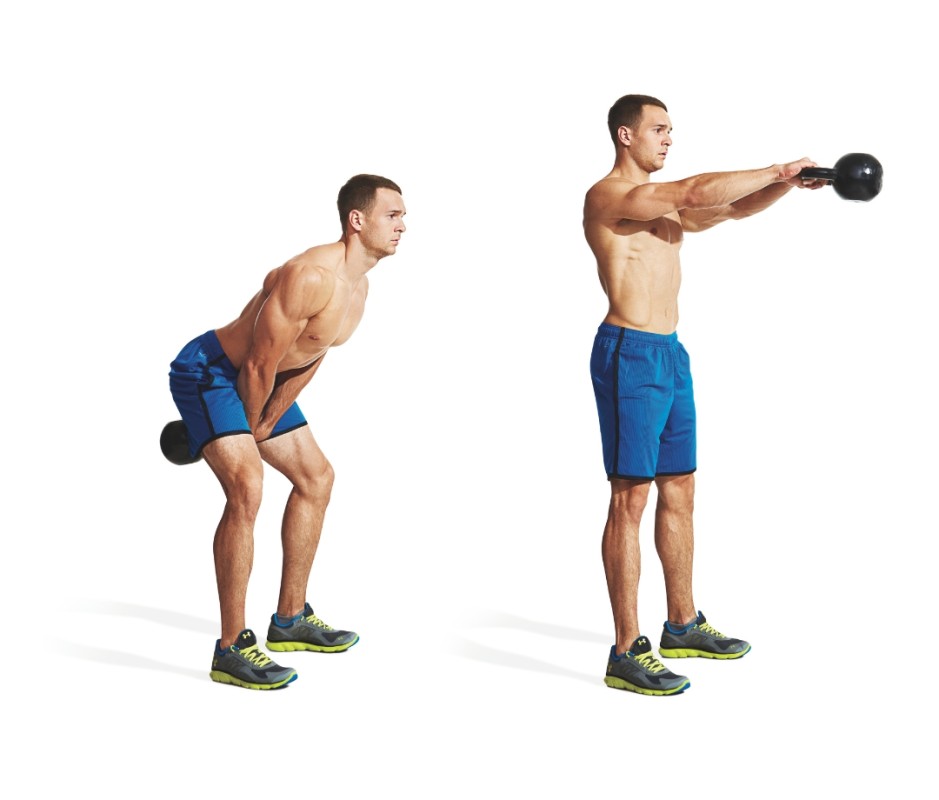
Beth Bischoff
The kettlebell swing is a dynamic hip-hinge exercise that’s similar to the Romanian deadlift, but with added power and speed. Being an explosive movement, it’s also a great way to boost your heart rate and improve your cardio.
How to Do It
- Start by placing the kettlebell between your feet, which should be about shoulder-width apart.
- With a slight bend in your knees, hinge at your hips, and reach down to grab the kettlebell handle with both hands, keeping your palms facing towards your body.
- Stand up with the kettlebell and then pull it back between your legs like you’re hiking a football.
- Then, in one smooth movement, drive your hips forward and squeeze your glutes as you stand tall. This motion will propel the kettlebell forward and up, with the goal of the kettlebell reaching chest height.
- Be sure to keep a tight core and strong wrists through the movement so that the bottom of the kettlebell is facing away from you at the end of the range of motion.
- Your arms should stay relatively straight but relaxed through the movement. Remember that you're not lifting the kettlebell with your arms but using the momentum created by your hips to drive the kettlebell away from your body.
- As the kettlebell swings back down, let it fall naturally, guiding it back between your legs by hinging at the hips.
- Immediately move into the next rep without stopping until you hit your target number of reps.
Related: How to Do the Renegade Row for Upper-Body Gains and Ironclad Core Strength
Who Should Do Deadlift Alternatives?
In reality, just about anyone can benefit from doing deadlift alternatives. Even if you’re able to perform a conventional deadlift, the exercises included on our list can help you build muscle, increase strength, and improve joint stability. That said, there are certain scenarios where choosing a deadlift alternative is the smarter and safer option.
Mobility Limitations
To properly and safely perform the deadlift, you need to have a decent range of motion through the ankles, hips, and thoracic spine. If you have some mobility limitations, choosing a deadlift alternative allows you to work within your current range of motion while still building strength in the same muscle groups the traditional deadlift targets. These alternative movements can also help improve your mobility and build proper movement patterns over time.
Chronic Pain
If you suffer from chronic pain in the hips, knees, or lower back, then a traditional barbell deadlift, even when executed properly, can be problematic. In these situations, incorporating a deadlift alternative into your workout may be beneficial. A study in the Journal of Sport Rehabilitation found that low-load motor control exercises can lead to improvements in both discomfort and function for folks living with chronic pain.
Many of our deadlift alternatives fall into this low-load motor control category, offering a way to build strength and reduce symptoms of pain over time. Our exercise variations include ways to reduce the total range of motion and modify the load, which can make the movements safer and more sustainable for individuals dealing with chronic pain.
Lack Equipment
If you don’t have access to a full gym setup that includes a barbell or heavy plates, then alternative deadlift exercises using dumbbells, kettlebells, or even your own bodyweight will work great. Exercises like kettlebell deadlifts, single-leg dumbbell deadlifts, and banded good mornings are excellent alternatives that require minimal equipment and still target the hamstrings, glutes, quads, and lower back. These movements also require less space and are easier to set up, making them great options for workouts at home or while traveling.






